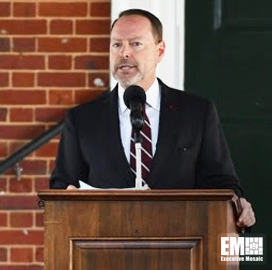By Kevin Plexico, Senior Vice President of Information Solutions at Deltek
In March, the Office of Management and Budget officially released the Biden Administration’s initial fiscal year 2024 discretionary budget request. This initial budget proposal includes a total of approximately $1.8 trillion in top-line discretionary budget requests for the federal department and various agencies. Earlier this year, I wrote about the return of budget uncertainty being one of the top 10 government contracting trends to watch in 2023, and the release of the U.S. Federal Budget Request helps to remove some of that uncertainty and bring some clarity to the federal government market.
The federal market analysis team behind Deltek’s GovWin IQ platform of government contracting intelligence has dug into the available budget detail in order to provide their first impressions of what they found noteworthy in the discretionary budget request, with a particular focus on spending priorities that may lead to potential contractor opportunities or create major impacts. They reviewed the largest federal departments’ budgets to get a sense of direction and priorities for FY 2024, which will begin October 1, 2023.
Below is a summary of key funding details from the five departments with the highest budgeted levels of spend: We’ve also included some key takeaways from the budget request for federal government contractors.
Federal budget request — top five agencies
The federal discretionary budget request allocates $842 billion to defense and $907.2 billion to civilian agencies and departments. The five departments receiving the most funding are the Air Force, Navy, Army, Health and Human Services and defense agencies.
Air Force
The president’s budget request provides $259.2B in total discretionary funding for the Department of the Air Force, a five percent increase over the FY 2023 enacted level. This includes $30.1 billion and $24.5 billion for the U.S. Space Force for FY 2024.
Funding highlights include:
- Operations and maintenance funding of $62.8 billion for the USAF and $5 billion for USSF, $1.7 billion and $929 million more than enacted in FY 2023, respectively.
- $60 billion for procurement at the USAF and $4.7 billion for the USSF. The USAF sees a $3.8 billion increase and USSF sees a $253 million increase from enacted FY 2023 levels.
- $46.6 billion and $19.2 billion for research, development, test and evaluation at the USAF and USSF respectively, representing $1.4 billion and $2.6 billion increases respectively from the enacted FY 2023 levels.
Navy
The president’s budget requests $255.8 billion for the Department of the Navy, an increase of $12.8 billion (5.3 percent) from the FY 2023 enacted level.
Funding highlights include:
- $82.5 billion for operations and maintenance, 3.8 percent more than the enacted FY 2023 level.
- $87.4 billion for procurement, 9.2 percent above the FY 2023 enacted level.
- $26.9 billion for research, development, test and evaluation, 3.4 percent more than the FY 2023 enacted level.
Army
The president’s budget requests $185.3 billion in discretionary funding for the Department of the Army, 0.21 percent more than enacted for FY 2023.
Funding highlights include:
- $59.6 billion for operations and maintenance, 4.6 percent less than enacted in FY 2023.
- $23.8 billion for procurement, 8.1 percent less than the level enacted in FY 2023.
- $15.8 billion for research, development, test and evaluation, 8.1 percent less than enacted in FY 2023.
Defense agencies
The president’s budget requests $141.7 billion in discretionary funding for defense agencies, 0.28 percent more than enacted for FY 2023.
Funding highlights include:
- $69.7 billion for operations and maintenance, 31.8 percent less than enacted in FY 2023.
- $6.0 billion for procurement, a reduction of 15.3 percent from the level enacted in FY 2023.
- $36.2 billion for research, development, test and evaluation, six percent less than the level enacted in FY 2023.
HHS
The president’s budget request provides $144.3 billion in discretionary budget authority for HHS, which is a 13.6 percent increase from the FY 2023 enacted level.
Funding highlights include:
- $20 billion in mandatory funding for HHS public health agencies to advance science, technology and core capabilities to prevent and prepare for future biological threats. Also includes $10.5 billion in discretionary funding to build public health capacity at the Centers for Disease Control and at the state and local levels for surveillance, laboratory and public health workforce capacities.
- Investment in the treatment and prevention of infectious diseases such as Hepatitis C, HIV and vaccine-preventable diseases, including an $850 million investment in the Ending the HIV Epidemic Initiative.
- $8.1 billion in discretionary resources for the Indian Health Service and proposes reclassifying the entire IHS budget as mandatory in FY 2025.
- $7.8 billion for the National Cancer Institute to drive progress on ways to prevent, detect and treat cancer.
- $1 billion dedicated to Cancer Moonshot activities across CDC, IHS, the Health Resources and Services Administration and the Food and Drug Administration to reduce the cancer death rate by at least 50 percent over the next 25 years and improve the experience of people who are living with or have survived cancer.
- $10 billion in information technology funding including $947 million for cybersecurity.
The summary points above are some of the initial observations from OMB’s budget document release. In the coming days and weeks as more details become available the GovWin Federal Market Analysis team will continue to share more thorough analysis of the FY 2024 budget, as they have done in this report: FY 2024 Federal Budget Request: Priorities and Opportunities.
Takeaways for government contractors
At a robust $1.8 trillion in total funding within the Biden-Harris Administration’s FY 2024 federal budget request, there is significant opportunity for companies of all sizes to help the federal government meet its goals. There will be plenty of prospects for businesses serving defense and civilian departments, providing all kinds of products and services—although there are a few industry areas that stand out.
The budget focuses on what have been some key priority areas for the Biden Administration. National security (especially Indo-Pacific and Russian deterrence) and cybersecurity are two of these priorities, fueled by security concerns related to China, Russia and technological progress. That focus on technological progress is something that continues from the previous fiscal year, with the federal government in particular continuing to spend on IT modernization, cloud computing and data analytics.
Another major focus area is research and development. The federal government’s desire to maintain its standing as a technological leader will lead to spending on R&D in areas such as artificial intelligence, high performance computing, quantum information systems, robotics, advanced communications technologies, biotechnology and cybersecurity. Other top spending priorities include infrastructure modernization (building on the Infrastructure Investment and Jobs Act), public health, climate resiliency and clean energy.
All this is just a surface-level scope of the FY 2024 federal budget. My colleague, Deniece Peterson, senior director of research for Deltek, went into greater detail on the key initiatives, investments and contractor implications coming from the budget in this webinar.
As we look ahead to 2024, some of the uncertainty still remains about the market in general and the federal government marketplace specifically. But contractors looking to get ahead of the competition can use this market intelligence to get a better sense of where the funding is flowing, understand what items are likely to remain priorities, and structure a long-term business development plan to support their government sales efforts.




